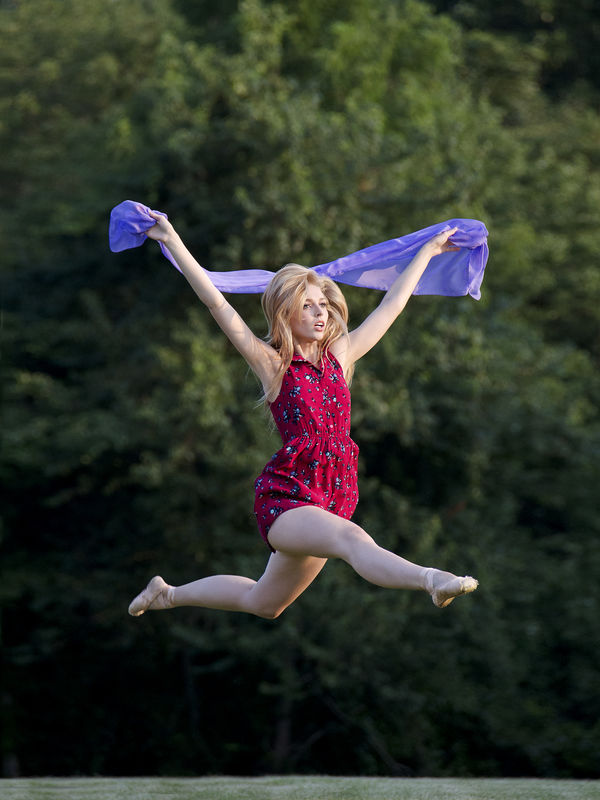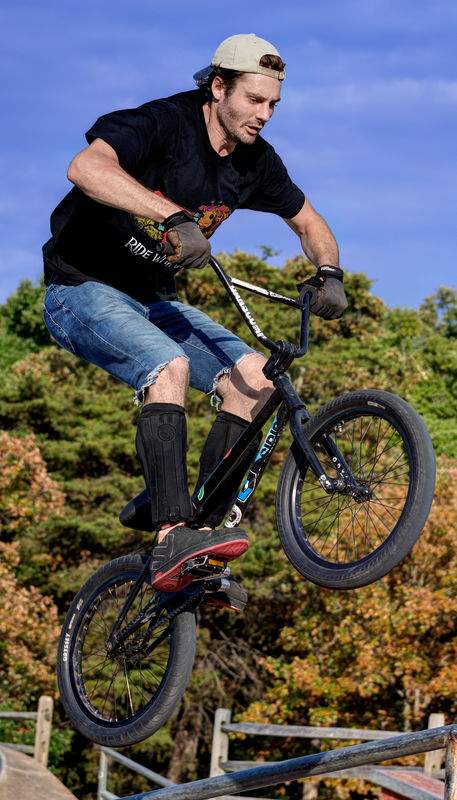Looking for a new telefoto lens
Mar 30, 2021 18:59:47 #
Joe,
You stated that the bluebird was shot with the camera on a tripod and using a remote shutter release.
Your "softness" could be camera shake. I didn't try to link at the data for your speed and fstop.
I was experimenting the other day with my 120-400 on the tripod and using a timer for the shutter. Outside in bright light, very fast shutter, like 1/2000. I dint recall exactly now.
I was a bit troubled that my shots, this was a test, were not as sharp as I would have expected. Then I remembered the mirror. My tripod is not exactly a rock and with me not holding the camera in my hands pressed up against my face the snapping up of the mirror was causing just 3nough of a tremor to screw up the image.
I activated mirror lock up and BANG, The test shot was sharp and crisp.
I'm not saying this IS your problem but please investigate all the other possible culprits before you start shopping.
You stated that the bluebird was shot with the camera on a tripod and using a remote shutter release.
Your "softness" could be camera shake. I didn't try to link at the data for your speed and fstop.
I was experimenting the other day with my 120-400 on the tripod and using a timer for the shutter. Outside in bright light, very fast shutter, like 1/2000. I dint recall exactly now.
I was a bit troubled that my shots, this was a test, were not as sharp as I would have expected. Then I remembered the mirror. My tripod is not exactly a rock and with me not holding the camera in my hands pressed up against my face the snapping up of the mirror was causing just 3nough of a tremor to screw up the image.
I activated mirror lock up and BANG, The test shot was sharp and crisp.
I'm not saying this IS your problem but please investigate all the other possible culprits before you start shopping.
Mar 30, 2021 19:17:30 #
WDCash wrote:
Joe, br You stated that the bluebird was shot with... (show quote)
Another One of the very good reasons for mirrorless cameras......

Mar 30, 2021 19:41:34 #
Mar 30, 2021 22:12:37 #
captxmas
Loc: San Francisco Bay Area
I was surprised that no one suggested the Sigma 60-600. Although the Nikon telephoto is great, I am truly impressed with the longer reach and quality of the image I capture with my Sigma. It is a bargain for what it delivers!
Mar 31, 2021 05:50:43 #
SteveR21
Loc: Oklahoma
I purchased the Sigma 150-600 lens and I love it. It is heavy, so a tripod is advantageous if you can use one.
Mar 31, 2021 06:47:45 #
imagemeister wrote:
Another One of the very good reasons for mirrorless cameras...... 



Mar 31, 2021 14:59:46 #
amfoto1
Loc: San Jose, Calif. USA
RCJets wrote:
Thanks to all who replied. I have posted on UHH a series of bluebirds on a post. They were taken at a distance of under twenty feet from a tripod mount with a remote shutter release. I have read several suggestions on what I could try to get a sharper shot, including checking for front or back focus. I haven't checked that yet, but will. As for my budget, I'm trying to hold it to around $600.
Thanks again for your comments. Any more suggestions are welcome.
Joe
Thanks again for your comments. Any more suggestions are welcome.
Joe
Hi Joe,
For "birding" you need as long a telephoto as you can get! 300mm really comes up short. I'd recommend no less than 400mm and even longer than that would be helpful.
Also, at these really long focal lengths image stabilization is very important. The more "affordable" telephotos 400mm or longer aren't "fast". They have small maximum apertures. That means you'll have to use slower shutter speeds and higher ISOs. To keep the ISO from being too high, where it will cause unwanted digital noise in your images, it's better to use a slower shutter speed. But then you have to worry about "camera shake blur" (and subject movement blur, though image stabilization can't help with that).
You also need as fast autofocus as possible, since typically birds don't hang around and patiently pose for photos.
In other words, with the longer focal lengths you'll be working "on the edge" of your camera's, lens' and your own capabilities. Glad to hear you have a tripod because you'll need it!
But, where does this leave us? Your $600 really isn't enough budget unless you happen upon a very favorable deal on something used or refurbished.
Popular lenses for birders are the Sigma and Tamron 150-600mm, along with the Nikon 200-500mm. All of these are rather large and heavy.... and significantly over your budget.
- Sigma 150-600mm f/5-6.3 "Contemporary" (or "C").... one of the most affordable of these "very long lenses", it's currently on sale for $900. It's also one of the lightest of these lenses at about 4 lb. But it's very "slow"... f/5 only from 150 to 179mm, then it drops 1/3 stop to f/5.6 until 387mm, where it loses another 1/3 stop to f/6.3 for the rest of the zoom range. It does have "OS" image stabilization and "HSM" ultrasonic focusing, which tends to be the fastest type.
- Tamron 150-600mm f/5-6.3 "G2" (2nd generation).... is also currently on sale, for $1200. It's about a half pound heavier than the Sigma 150-600mm C, but the Tamron is slightly faster... maintains a little bit larger apertures slightly farther into it's focal length range. The difference isn't huge, but sometimes even 1/3 stop of additional light is the difference between getting a shot or not. This lens is one of the newest and has some of the best image quality of this group of lenses. It too has image stabilization (VC) and ultrasonic autofocus (USD). Plus a nice thing Tamron has done with their most recent lenses is an Arca-compatible dovetail built right into the tripod mounting foot, if you use that quick release system on your tripod (the Arca system is the most universal and in fact is necessary to use most gimbal mounts, if that's a consideration). All these lenses come with a tripod mounting collar (in some cases removable, though that might not be wise with these big lenses).
- Nikkor AF-S 200-500mm f/5.6 VR... is a popular lens among Nikon shooters, currently selling for $1397. The image quality it produces is on par with the Tamron G2 and the more expensive Sigma "Sport" lenses. It's "only" 500mm, but because it has a non-variable f/5.6 aperture it ends up being a bit bigger and heavier at about 5 lb. While it has a tripod mounting collar, if Arca-style quick release comparability is wanted, it doesn't work very well with more affordable "universal" lens plates ($25-$30). Instead many users choose to replace the tripod foot (costs between $100 and $120) or even replace the entire tripod collar (around $250). Obviously this adds a lot to the cost of using the lens.
- Sigma 150-600mm f/5-6.3 OS HSM "Sport" ("S)... is a pricier, more robust and "pro-oriented" lens. It's currently on sale for $1849. With more weather sealing and durable build, it also is heftier at more than 6 lb.
- Discontinued Tamron 150-600mm (first version).... if you shop used you'll find these for less money than the above. General specs are similar to the "G2", but this lens doesn't have as good image quality as the newer Tamron, Nikkor or the Sigma Sport.
https://www.bhphotovideo.com/c/compare/Sigma_150-600mm_f_5-6.3_DG_OS_HSM_Contemporary_Lens_for_Nikon_F_vs_Tamron_SP_150-600mm_f_5-6.3_Di_VC_USD_G2_for_Nikon_F_vs_Sigma_150-600mm_f_5-6.3_DG_OS_HSM_Sports_Lens_for_Nikon_F_vs_Nikon_AF-S_NIKKOR_200-500mm_f_5.6E_ED_VR_Lens/BHitems/1082155-REG_1277357-REG_1082151-REG_1175034-REG
Are you having "sticker shock" yet? Well, there may be some more affordable alternatives worth considering. They don't have as long focal length and are typically a bit smaller and maybe a little lighter too.
- Nikkor AF-S 80-400mm f/4.5-5.6 VR... I'm including here for sake of comparison because at almost $2300 it's way more than you wanted to spend! It's a very capable, solid, pro-quality lens.
- Tamron 100-400mm f/4.5-6.3 VC USD.... is currently selling for $799 new. Among this group of lenses, it's one of the "brighter" ones. It maintains f/4.5 or f/5 to 180mm, drops to f/5.6 to 280mm, and then is f/6.3 the remainder of the focal length range. One of the best features of this lens is that it's designed to be able to fit an optional tripod mounting ring. That's sold separately and costs an additional $129, but is not even possible with the Sigma 100-400mm or the Tamron 18-400mm. Personally I wouldn't want a 400mm lens without a tripod mounting collar!
- Sigma 100-400mm f/5-6.3 OS HSM... costs the same $799 as the above Tamron. They are very similar weight, too, at approx. 2.5 lb. And they both use 67mm size filters. However, this Sigma is less bright. It starts out 1/3 stop dimmer at f/5 and only maintains that to 111mm, then is only f/5.6 230mm, dimming down to f/6.3 the remainder of the zoom range. And, as mentioned, there's no option of adding a tripod ring to this lens.
- Tamron 18-400mm f/3.5-6.3 VC HLD... is the only lens listed here that's within your budget at $599. It's smaller and lighter than the others too, at 1.5 lb. But it's also an extreme range zoom which means there will be some compromise. Don't expect image quality to be quite as good, though it's surprising for a lens of this type. Probably bigger concerns are that it uses a different autofocus drive (high/low torque "HLD" Tamron calls it, whatever that means). All the other lenses listed here have fast ultrasonic focus drive. Plus, this lens is the dimmest of the bunch. Sure, at 18mm it's faster with f/3.5, but that starts to dim down quickly as you zoom... to f/5 by 50mm and f/5.6 by 89mm, then it's f/6.3 from 117mm onward! Less light for the autofocus system to work with won't be helpful and this lens will be hard to use in challenging lighting conditions. Keep in mind that in addition to forcing slower shutter speeds and higher ISOs, smaller lens apertures also mean less control over depth of field, less ability to blur down backgrounds to make subjects stand out.
https://www.bhphotovideo.com/c/compare/Tamron_100-400mm_f_4.5-6.3_Di_VC_USD_Lens_for_Nikon_F_vs_Sigma_100-400mm_f_5-6.3_DG_OS_HSM_Contemporary_Lens_for_Nikon_F_vs_Nikon_AF-S_NIKKOR_80-400mm_f_4.5-5.6G_ED_VR_Lens_vs_Tamron_18-400mm_f_3.5-6.3_Di_II_VC_HLD_Lens_for_Nikon_F/BHitems/1362803-REG_1321313-REG_936121-REG_1345956-REG
My recommendation, increase your budget a bit. In the long run I think you will probably be a lot happier. A bit more money will buy you a better, more useful lens. You also might shop used and/or refurbished. Be careful though. The best used equipment retailers back their sales with a store warranty and no-questions asked return policy. Less reputable used gear sellers might not be around if anything goes wrong, may sell gray market items you have difficulty getting repaired or might claim something is refurbished (by whom?). You might check the manufacturers' websites, where they now often directly offer factory refurbished and offer some warranty.
Hope this helps!
Mar 31, 2021 16:36:53 #
Good commentgs. I used to do some shooting with a 30-06, so I'm familiar with what you are talking about. The bluebirds were shot using a tripod and a remote release. Since I was pretty close to the birds and thier nest, I had prefocused on one of the birds and then waited until one landed on the post and then I released the shutter. I will admit that I could not have focused on each birds eys, considering how I took these.
Apr 1, 2021 06:44:54 #
amfoto1 wrote:
Hi Joe, br br For "birding" you need a... (show quote)
Add to this recommendation
1) search for a refurbished lens preferably refurbished by the manufacturer.
2) you can also buy from places like B&H or Adorama. They have very good return policies that allow you to try out the lens and return it usually with no restocking fee. Do not rent as that will simply reduce the amount you have for your purchase.
But otherwise Alan is right again.
Apr 1, 2021 09:27:28 #
"...I'm considering the Nikon 18-300 DX for my D7100. I have heard it is a very sharp lens..." RCJets who told you this? I had the AF-S 18-300mm f/3.5-5.6 ED VR and used it extensively for several years on a D7000 then a D7100. This DX 16x zoom is decidedly not a professional grade optic. I suffers from marked focus breathing and isn't a 300mm FL especially at portraiture distance. While it has a reasonably quality build (by Nikon Prosumer standards) it simply has been passed in the prosumer camp by the Lens that Paul recommended in your price range. That being the AF-P 70-300mm f/3.5-5.6 VR (Note: only the FX version, the DX version isn't in the same league).
Rather than pontificating about either lenses I've simply posted imagery from both the aforementioned Nikkors... You be the judge here.
Caveat: Not a bird enthusiast, pretty much a Sports, Fashion and Portrait shooter.
Hope either of these images may help...
Please enjoy your retirement RCJets... Cheers!
.
Rather than pontificating about either lenses I've simply posted imagery from both the aforementioned Nikkors... You be the judge here.
Caveat: Not a bird enthusiast, pretty much a Sports, Fashion and Portrait shooter.
Hope either of these images may help...
Please enjoy your retirement RCJets... Cheers!
.
prét-á-porter Fashion with the AF-S 18-300mm f/3.5-5.6 ED VR Nikkor (D7000)

(Download)
BMX Rider doing bunny hops with the AF-P 70-300mm f/3.5-5.6 VR FX Nikkor (D7200)

(Download)
Apr 1, 2021 13:27:38 #
amfoto1
Loc: San Jose, Calif. USA
RCJets wrote:
Good commentgs. I used to do some shooting with a 30-06, so I'm familiar with what you are talking about. The bluebirds were shot using a tripod and a remote release. Since I was pretty close to the birds and thier nest, I had prefocused on one of the birds and then waited until one landed on the post and then I released the shutter. I will admit that I could not have focused on each birds eys, considering how I took these.
Hi again Joe,
I just took a look at your bluebird photos that you've been referencing.
They look overall "soft" in an odd way which leads me to the following question...
Do you have a "protection" filter on the lens?
If so, I'd highly recommend you remove it and try the lens without it. I've seen images spoiled in a very similar manner by poor quality filters. If you don't already use one, a matched lens hood would be a good idea for "protection", in fact better than some thin piece of glass (plus a hood helps make for the best possible color and contrast in images... though it will be no real help in terms of focus accuracy or sharpness).
If you don't have a filter on the lens, then I suspect the lens itself is "out of whack" in some way. That doesn't look like "missed focus" to me. Maybe I'm wrong, but I don't think calibrating the lens on your camera will help because I'm not seeing "front focusing" or "back focusing"... just overall mis-focusing.
Above I discussed some possible replacements, any of which would make better images than those. Some would be MUCH better.
You speculate about whether the FX lens on a DX camera is part of the problem. It's not. In fact, usually that makes for BETTER image quality than some DX lenses offer. I don't know all the different versions of Nikkor 70-300mm, but most lenses are sharpest in the middle and least sharp, lower resolution in the periphery, toward the corners of the images. Most lenses also have some light fall off toward the corners (vignetting). When you use an FX lens on a DX camera you essentially "crop away" the weakest parts of the lens. So you actually might expect an FX lens to work BETTER than a comparable DX lens that produces a smaller image circle (just sufficient to cover the smaller image sensor in the camera).
Again, I don't have experience with the various Nikkor 70-300mm lenses. There may be an instance where a newer DX lens is better than an older FX lens. I don't know. Maybe people with more experience with the different Nikkor 70-300s could chime in here. There may be some good info elsewhere online too. By the way, this is a good example why it's important to be very specific what lens you're using for images. You only told us it's a 70-300 initially. Later we learned that it's an FX version and has VR. I still don't know if that covers all the bases... if Nikon has made different versions of 70-300mm VR FX lenses... maybe an AF-S version and an AF-P version? Maybe some difference in lens aperture range? Are they all f/4.5-5.6 like yours? All these questions might be answered if you had simply included the full lens designation... and that in turn might lead to better answers such as "that's not a good version" or "that's a great lens, something is wrong with yours or how you're using it".
Finally, the overall image blur I'm seeing also may be due to "camera shake". You used 1/500 shutter speed for these and that's marginal when using a 300mm focal length on a DX camera. The first image at 1/200 is even worse. Did you have VR on or off? That might help with camera shake (wind? trucks driving by? even the DSLR's mirror action?). But it can't help with subject movement. Nikkor 70-300mm VR lens users might be able to tell us if that's a problem or helpful when on a tripod. Simply bumping up from ISO 100 to ISO 200 might have helped a lot by increasing your shutter speed to 1/1000. I'm sure your camera is capable of making fine images at just slightly higher ISO... probably even could have gone higher with it, though it even faster shutter speeds may not have helped.
I hope you don't mind, I wanted to see what was possible and downloaded one of your images to try sharpening it in Photoshop. I didn't want to mess up the lovely background blur of the image, so I used layers and masks to selectively sharpen just the bird and the post. I used both a high pass filter and unsharp mask sharpening techniques. In the end only so much is possible, though I think you could make a decent 8x10" or 8x12" print from the sharpened shot. It's usable for a moderate size like that, but still "falls apart" any larger (such as at the max view here on UHH). Below is the result (and below that is a re-post of your original, for side by side comparison, notice how the sharpening brings out more fine details throughout)...
P.S. The cricket doesn't look happy

If you want to reply, then register here. Registration is free and your account is created instantly, so you can post right away.







